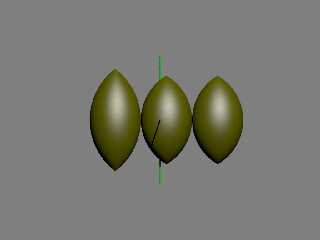|
 |
On 3/12/23 08:45, Bald Eagle wrote:
> Perhaps an interesting thing to have available in povr would be a "global
> bounding box" for the scene in the render statistics. It could help clue scene
> authors in to overlooked distance issues and maybe help track down spuriously
> placed objects, as well as resolve other weird issues.
I'm thinking some about this and unsure how to do it in any general way
that would not often raise false alarms.
> On to the trivial solution.
> Spindle torus, did you say?
I'll write more about accuracy stuff here so folks are not left too
'depressed' about higher order inbuilt shapes like the lemon. ;-)
Attached is another image with three shapes left to right where the
orthographic camera is again pulled back about -2000 from the origin
where the shapes sit. In fact even -2e6 is no problem.
The middle and right shapes are an isosurface, f_torus 'intersect'
spindle and on the right is the torus 'intersect' spindle. A good
question is why do these shapes seem to be immune to the camera set back
(to the long ray length)?
The answer is both shapes have low order container shapes which are in
fact the first intersection. The isosurface shape uses either a box or a
sphere(a) which users specify as the container. The torus internally
creates a bounding sphere which is the first intersection(a).
On the left is again the lemon, but now it works! It does because I did
this:
union {
box { -1,1 pigment {rgbt <0,0,0,1>} } // <--- low order bounding(a)
lemon {
<0, -Y, 0>, 0, <0, Y, 0>, 0, r
texture {pigment {rgb <0.2, 0.2,0>} finish {specular 0.4}}
//sturm
}
translate <-.7,0,-.1>
}
Bill P.
(a) - This kind of outer bounding certainly helps and is often a decent
work-around, but it is not a general solution. For example, when the
shapes themselves are large (big interior) - as the ray->surface
equation and solvers see the shape. Or where the type of csg forces the
from camera intersections.
The union, clear, first shape bounding can also introduce issues /
artefacts with other shapes in the scene because that invisible surface
exists in the scene.
Aside: An attractive argument for representing all shapes with low
order, mesh approximations is those low order (simpler) ray->surface
equations tolerate MUCH longer ray to surface distances on cpu float
hardware.
Post a reply to this message
Attachments:
Download 'behmmisotorusspindle.png' (77 KB)
Preview of image 'behmmisotorusspindle.png'

|
 |




![]()